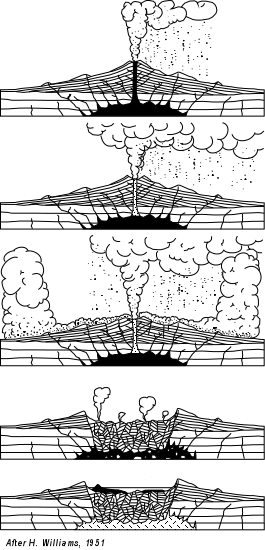Looking inside the structure of the Yellowstone Caldera
With all the talk of the current Yellowstone earthquake swarm, I thought it would worth it to write a post on the the structure and caldera – and why we get earthquake swarms that are structurally rather than magmatically-related.
First off, lets think about why calderas formed. This is relatively simple – at least superficially. The land (or volcano) above a magmatic system is partially supported by that magma, especially because magma is hot and buoyant. The isostatic support by the magma holds up the land surface or volcanic edifice, so when an eruption expels a large volume of magma, this support is removed. This collapse forms the caldera – the negative topographic expression of the eruption. The collapse of the land surface plays a dual role – not is it a result of the eruption, but also helps the eruption along, like a piston pushing of hot gas out of a cylinder. After the eruption, the collapsed caldera continues to subside as the isostatic equilibrium is reached. After the caldera-forming eruption{caution, large PDF}, the system may have eruptions that produce resurgent domes in the middle of the caldera as the last dregs of the caldera-forming magmatic system leak out. This is referred to as the “caldera cycle”, originally defined by Howell Williams for the collapse of Mt. Mazama ~7,700 years b.p. (see below).

Modified illustration of the caldera cycle by Howell Williams.
The collapse of the caldera produced what is called the “ring fracture,” the fracture along the edge of the caldera. This fracture was formed during the collapse, but was then likely also exploited by the erupting magma during the caldera-forming eruption. These fractures then become long lived zones of weakness around the edge of the caldera (see below) – the down-dropped part of the caldera is no longer supported by either the emptied magma chamber or the crust around it.

Map of the extent of Yellowstone Caldera. The ring fractures from the caldera-forming eruptions are roughly coincident with the caldera.
We can look at the general structure of caldera systems by looking at the Long Valley Caldera (see below). The ring fracture is present on the edge of the Long Valley caldera, with the down-dropped caldera material in the middle – filled in by the tephra from the caldera-forming eruption and resurgent dome material. The caldera may continue to settle for hundreds of thousands of years after the caldera-forming eruption – all happening at depths at or above the current “top” of the magmatic system.

A schematic look at the structure of the Long Valley caldera in California.
If we take a look at historical seismicty around Yellowstone (see below), we can see that quite a bit it is near the ring fracture of the caldera. This means that thesuggested structural source of the current seismicity makes sense – as I’ve mentioned, the earthquakes in these locations in historic times have not lead to eruptions. In fact, we should expect to see a lot of low scale seismicity along the ring fracture that represents the many faults related to the ring fracture system.

Historic seismicity around Yellowstone Caldera.
However, as zones of weakness, you might expect that magma could exploit the ring fracture to reach the surface. Magma rising would need corroborating evidence, though. Magma doesn’t do a good job of disguising its present, especially large volumes. The ground should deform from the additional volume of magma displacing the crust and this displacement with our current methods of measuring ground changes should be detected well in advance of an eruption. We should also expect changes in the hydrothermal system as the hot body of magma moves higher into the system, possibly in the form of new mud pots, geysers or hot pools. The chemistry of springs might change as well, reflecting the input of magmatic components into the water – which goes hand-in-hand with changes in gases being released by the magma. Volatiles like water vapor, CO2, SO2 and He are constantly being released by a cooling, depressuring magma, so we should see the signal of this in the gases being released at Yellowstone, especially by monitoring dissolved gases in springs. The type of earthquakes should also change – not only becoming shallower, but also taking on the classic pattern of harmonic volcanic tremor – the harbinger of moving magma.
YVO monitors many, if not all, of these factors, so we are not likely to be “surprised” by any new eruptions at Yellowstone. While the current earthquake swarm does appear to be getting shallower, you can see how it is part of life at an active caldera system. You can check the current status of the Yellowstone Caldera on the YVO website.




